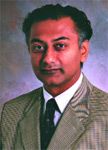Article
Frequent imaging, examination key to monitoring glaucoma
Halifax, Nova Scotia-The detection of change is an important finding for both the diagnosis of glaucoma and monitoring its progression. In fact, from the perspective of the instrument or the technique, these two things are completely interchangeable, according to Balwantray C. Chauhan, PhD, professor and research director, Department of Ophthalmology and Visual Sciences, Dalhousie University, Halifax, Nova Scotia, Canada.
Halifax, Nova Scotia-The detection of change is an important finding for both the diagnosis of glaucoma and monitoring its progression. In fact, from the perspective of the instrument or the technique, these two things are completely interchangeable, according to Balwantray C. Chauhan, PhD, professor and research director, Department of Ophthalmology and Visual Sciences, Dalhousie University, Halifax, Nova Scotia, Canada.

"Ultimately, it probably doesn't matter as long as you do the examinations very well," he said. "The quality of the examinations and the images is absolutely critical, as is the frequency of examinations. The more frequently that you can perform imaging in your patients, the better off you are."
"Modern imaging techniques have an important role in detecting early change, and over the upcoming few years, we will have more and more evidence to support this statement," he continued.
Conventional techniques
However, conventional techniques for detecting glaucomatous progression such as disc photography and ophthalmoscopy have been around a long time and have many advantages.
"They can be quick and they are still very relevant today," Dr. Chauhan said. "Disc photography gives us real stereo and real color information. But there are some limitations. Subtle changes in the optic disc can be missed if we do not have documentation such as images that can be archived. And even if we do, in a busy clinical set-up, it may be difficult to detect these types of changes."
He added that photography can be very time-consuming if one wants to follow patients closely and detect the earliest changes. And although nerve fiber layer photography is unparalleled in its ability to document progression, few centers are able to produce such images.
Modern imaging techniques are generally less time-consuming, can be performed without pupil dilation, and offer tremendous promise. A range of technologies is available, and the images are easy to store and retrieve.
However, the disadvantages include the high initial cost of purchasing the equipment and rapid obsolescence.
"These techniques may be around only until the next best thing comes along, and then you have to replace it," Dr. Chauhan said. "There is always a danger of that because the technology is constantly changing."
The relative newness of these devices means a lack of long-term data on their effectiveness.
"Unfortunately, we have limited experience about how these techniques do over a long period," he said. "Most of the experience comes from scanning laser tomography, but there is some evidence that optical coherence tomography can be used to follow patients."
One of the ways to detect abnormalities is to see how a particular disc falls within the normal population. Applying the precept that the larger the disc, the larger the neuroretinal rim, the clinician can place confidence bounds around the relationship to produce bounds for borderline situations and situations where the disc is outside of normal limits, Dr. Chauhan explained.
When an optic disc changes, it may move from within to outside of normal limits, and this is a valid use of cross-sectional tools to detect progression. However, Dr. Chauhan cautioned that a disc may change and still remain within normal limits and therefore the use of cross-sectional tools may be inappropriate.
He stressed that evidence of change in itself can be used as a diagnostic clue for glaucoma and again that multiple examinations in an individual are essential.





